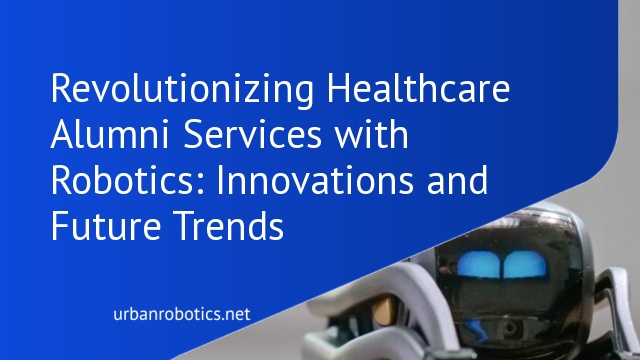Understanding Healthcare Alumni Services
Healthcare alumni services aim to connect former students and professionals with their alma mater, peers, and the broader medical community. These services focus on networking, professional development, and continued education. By fostering relationships, they enhance career opportunities and support medical advancements.
Several key components define these services:
- Networking Events: Alumni attend conferences, seminars, and workshops.
- Mentorship Programs: Experienced professionals mentor recent graduates.
- Continuing Education: Alumni access courses and training.
By leveraging robotics, these services enhance engagement and collaboration. Robotics facilitates remote interactions, making it easier for alumni to participate regardless of location. Through virtual meetups, alumni share insights and stay updated on industry trends. Furthermore, robotic platforms support remote surgeries and training simulations, enriching educational experiences.
Incorporating robotics into healthcare alumni services transforms traditional engagement methods, providing innovative ways for professionals to connect and grow.
Evolution of Robotics in Healthcare
Robotics in healthcare has transformed dramatically over the past decades. The journey began with simple automation and has now reached sophisticated robotic systems enhancing medical procedures and alumni services.
Early Developments
Robotics in healthcare started with basic automation tasks in the late 20th century. In 1985, the PUMA 560 robotic arm performed a delicate neurosurgical biopsy, marking a significant milestone. Early developments focused on precision and repetitive task execution, reducing human error in surgeries and diagnostics. During the 1990s, the introduction of laparoscopic surgery tools allowed minimally invasive procedures, significantly impacting patient recovery times.
Modern Innovations
Contemporary innovations in healthcare robotics include surgical robots, telepresence robots, and rehabilitation robots. The Da Vinci Surgical System, introduced in 2000, revolutionized minimally invasive surgery with enhanced precision and control. Telepresence robots facilitate remote interactions between healthcare providers and patients, essential for alumni participating in virtual medical conferences and remote training. Rehabilitation robots, like exoskeletons, aid in patient recovery, offering advanced therapy options and continuous monitoring.
Benefits of Integrating Robotics with Alumni Services
Integrating robotics in healthcare alumni services offers numerous advantages, enhancing various aspects of communication, record-keeping, and training.
Improved Communication
Alumni services benefit significantly from the integration of robotics, which enhances communication by enabling real-time interaction across the globe. Telepresence robots allow alumni to participate in virtual meetings, conferences, and medical forums without geographical constraints. These robots facilitate face-to-face conversations, improving networking and collaboration opportunities among healthcare professionals.
Enhanced Record Keeping
Robotics ensures enhanced record-keeping by automating data entry and management tasks. Robots equipped with advanced AI can efficiently organize alumni records, ensuring accuracy and reducing manual errors. These systems enable quick retrieval of information, making it easier for alumni to access historical data and stay informed about their achievements and contributions to the healthcare field.
Continuing Education and Training
Robotics plays a vital role in continuing education and training for healthcare alumni. Simulation robots and virtual reality platforms offer immersive training experiences, allowing alumni to practice and refine their skills in a risk-free environment. These technologies support ongoing professional development, ensuring that healthcare professionals remain at the forefront of medical advancements and best practices.
Case Studies
Healthcare alumni services have significantly benefited from the integration of robotics. Below, we explore specific examples illustrating these advancements.
Successful Implementations
The Mayo Clinic has integrated telepresence robots into their alumni networking events, enhancing real-time communication for professionals worldwide. Stanford Medicine uses simulation robots in their continuing education programs, offering hands-on training remotely. These implementations show how robotics can provide seamless interaction and top-notch training.
Lessons Learned
Key insights from implementing robotics in alumni services include the necessity of robust technical support and the importance of user-friendly interfaces. Organizations like Cleveland Clinic found that investing in comprehensive training for both staff and alumni boosted the overall effectiveness of these technologies. These lessons highlight the essential factors for successful integration.
Future Prospects and Trends
Healthcare alumni services will experience substantial growth with advancements in robotics. Artificial intelligence (AI) and machine learning (ML) will drive significant innovations. Predictive analytics will streamline alumni engagement, offering personalized recommendations for events, courses, and networking opportunities.
Virtual Reality (VR) combined with robotics will elevate remote training programs. Alumni could participate in lifelike simulations, enhancing their skills and knowledge. Blockchain technology will ensure secure and transparent data management, bolstering trust among alumni networks.
5G integration will enhance the performance of telepresence robots, facilitating real-time interactions and reducing latency issues. Wearable robotics, such as exoskeletons, will support continuous monitoring, enabling alumni to track their health metrics remotely.
Robotics will enable global collaboration platforms. Healthcare professionals will exchange expertise and resources seamlessly, fostering a global network of knowledgeable practitioners.
The integration of such technologies will redefine alumni services by making them more interactive, efficient, and valuable to all members involved.
Conclusion
The integration of robotics in healthcare alumni services is transforming how we connect and collaborate. By leveraging advanced technologies like AI and VR we’re not only enhancing remote training but also ensuring secure data management with blockchain. As we embrace these innovations the potential for global collaboration grows making our alumni services more interactive and efficient. The future is bright for healthcare professionals as we continue to push the boundaries of what’s possible with robotics. Let’s stay committed to adopting these advancements to enrich our community and improve outcomes for all.





